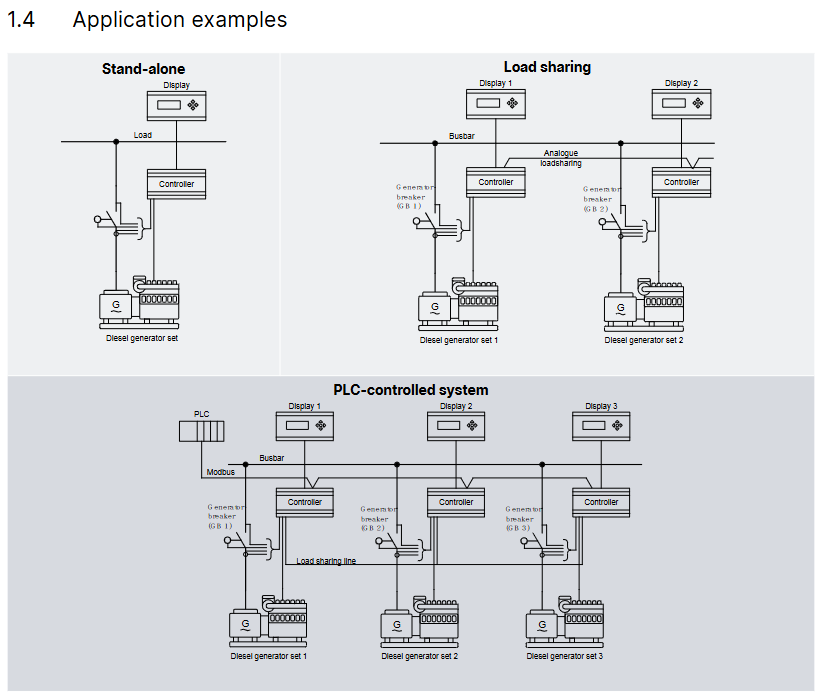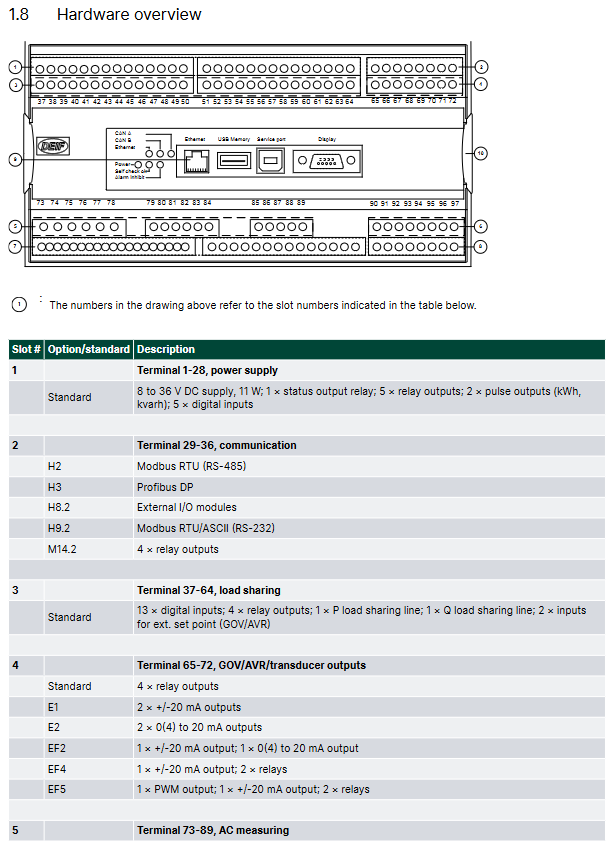DEIF PPU-3 Parallel and Protection Unit
Stand alone operation: independent power supply control for a single generator;
Parallel with other generators: Multiple generators are synchronized in parallel to achieve load distribution and coordinated control.
Its core value lies in simplifying the generator control chain, which can be connected to the PLC control system through digital/analog I/O or serial communication, and has flexible functional expansion capabilities.
DEIF PPU-3 Parallel and Protection Unit
Product basic positioning and core applications
PPU-3 is a compact microprocessor control unit launched by DEIF, which integrates the protection and control functions of synchronous/asynchronous generators in an "integrated" design. It has a built-in galvanized separated three-phase measurement circuit and is designed for ship application scenarios. It supports two core working modes (which can be combined):
Stand alone operation: independent power supply control for a single generator;
Parallel with other generators: Multiple generators are synchronized in parallel to achieve load distribution and coordinated control.
Its core value lies in simplifying the generator control chain, which can be connected to the PLC control system through digital/analog I/O or serial communication, and has flexible functional expansion capabilities.

Core functional modules
(1) Display and operation unit
Display configuration: The display unit (DU-2) is independently designed and can be directly installed on the host or at the front end of the distribution cabinet door (with a standard 3m display cable). A single PPU-3 can expand up to 2 additional display units (up to 200m away);
Display content: Real time display of all measured values, calculated values, alarm information, and event logs;
Extended operation panel: Optional AOP-1 (16 configurable LEDs+8 configurable buttons) or AOP-2 (16 configurable LEDs+8 configurable buttons+1 status relay), supporting CAN bus communication.
(2) Regulation Modes
According to the control object (governor/automatic voltage regulator), provide multiple types of switchable standard regulation modes to meet different operational requirements:
Specific functions of control object adjustment mode
Governor maintains a fixed frequency to maintain stable generator output frequency
Fixed power (base load) setting for fixed active power output
Frequency droop automatically adjusts the frequency as the load changes, adapting to parallel load distribution
Load sharing: Balanced allocation of active loads when multiple machines are connected in parallel
Automatic voltage regulator (AVR, optional option D1) with fixed voltage to maintain stable generator output voltage
Fixed reactive power setting for fixed reactive power output
Fixed power factor maintains power factor stability
Reactive load sharing: Balanced allocation of reactive load when multiple machines are connected in parallel
Voltage droop automatically adjusts voltage with changes in reactive load, suitable for parallel scenarios
(3) Self checking and configuration tools
Self test: Perform periodic self tests at startup, display fault information in plain text on the screen, and trigger alarms through relay outputs (status outputs);
M-Logic (Micro PLC): Free integration into PC tool software, supports custom input/output functions and logic conditions, and adapts to personalized application scenarios;
Configuration method:
Local: configured through the password protection menu of the display unit;
Remote: Connect to a PC via USB and use the free Windows version PC tool software (available from the DEIF download center), which supports parameter monitoring, configuration saving/downloading, and firmware updates.
(4) Engine control and protection (optional function)
After installing the engine control and protection module, the PPU-3 can achieve:
Engine start stop sequence control;
Engine protection function: Provides a complete backup of the engine shutdown channel in case of main processor failure, ensuring equipment safety.
(5) CANshare function (optional G9 option)
CANshare provides:
Digital load distribution and line fault (disconnection, short circuit) monitoring;
Support position feedback and monitoring of up to 4 bus circuit breakers (BTBs);
Manage up to 5 load distribution segments;
Monitoring of active/reactive load distribution;
Dead bus closing and first startup discrimination;
Simulation testing mode before debugging.

Standard protection functions (Protections)
PPU-3 is equipped with multiple protection functions that comply with IEEE Std. C37.2-1996 (R2001) standards, covering core fault scenarios of generators and busbars. Some functions support multiple threshold settings:
Protection Function ANSI Number Threshold Order Core Function
Generator reverse power (32) 2nd order to prevent the generator from absorbing grid power (such as when the turbine loses steam)
Generator over current (50/51) 6th order protection of the generator from overload current damage
Voltage dependent overcurrent (51V) 1st order combined with voltage state to determine overcurrent and avoid false triggering
Inverse time over current (51) The larger the first-order current, the shorter the action time, making it suitable for different overload scenarios
Generator over/under voltage (59)/(27) 2nd/3rd order protection for generator insulation and load from overvoltage/undervoltage impact
Generator over/under frequency (81) 3rd/3rd order to prevent frequency deviation caused by abnormal generator speed
Busbar over/undervoltage (59)/(27) 3rd/4th order protection for busbars and downstream loads from overvoltage/undervoltage damage
- EMERSON
- Honeywell
- CTI
- Rolls-Royce
- General Electric
- Woodward
- Yaskawa
- xYCOM
- Motorola
- Siemens
- Rockwell
- ABB
- B&R
- HIMA
- Construction site
- electricity
- Automobile market
- PLC
- DCS
- Motor drivers
- VSD
- Implications
- cement
- CO2
- CEM
- methane
- Artificial intelligence
- Titanic
- Solar energy
- Hydrogen fuel cell
- Hydrogen and fuel cells
- Hydrogen and oxygen fuel cells
- tyre
- Chemical fiber
- dynamo
- corpuscle
- Pulp and paper
- printing
- fossil
- FANUC
- Food and beverage
- Life science
- Sewage treatment
- Personal care
- electricity
- boats
- infrastructure
- Automobile industry
- metallurgy
- Nuclear power generation
- Geothermal power generation
- Water and wastewater
- Infrastructure construction
- Mine hazard
- steel
- papermaking
- Natural gas industry
- Infrastructure construction
- Power and energy
- Rubber and plastic
- Renewable energy
- pharmacy
- mining
- Plastic industry
- Schneider
- Kongsberg
- NI
- Wind energy
- International petroleum
- International new energy network
- gas
- WATLOW
- ProSoft
- SEW
- wind
- ADVANCED
- Reliance
- YOKOGAWA
- TRICONEX
- FOXBORO
- METSO
- MAN
- Advantest
- ADVANCED
- ALSTOM
- Control Wave
- AB
- AMAT
- STUDER
- KONGSBERG
- MOTOROLA
- DANAHER MOTION
- Bently
- Galil
- EATON
- MOLEX
- Triconex
- DEIF
- B&W
- ZYGO
- Aerotech
- DANFOSS
- KOLLMORGEN
- Beijer
- Endress+Hauser
- MOOG
- KB
- Moxa
- Rexroth
- YAMAHA
- Johnson
- Westinghouse
- WAGO
- TOSHIBA
- TEKTRONIX
- BENDER
- BMCM
- SMC


Email:wang@kongjiangauto.com


































































































































